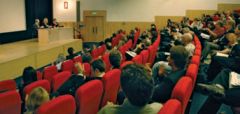Preservation community calls for action to safeguard information
Siân Harris reports from the iPRES 2008 conference

‘There is an opportunity for Europe and the world. Let’s not wait until the last moment. Our children and grandchildren will be grateful.’
These stirring words from Horst Forster, the director responsible for digital content and cognitive systems in the European Commission’s Directorate General for Information Society and Media, were part of his keynote speech at the recent iPRES event held at the British Library.
Forster was speaking about digital preservation and, as the conference sessions continued, the enormity of the task he referred to was revealed. ‘While born digital content is emerging in all areas, ways to preserve it are far behind,’ he said.
The first problem is that there seems to be a lack of interest or understanding about preservation. Forster pointed out that the role of digital curator has not really been defined yet and there are very few specialist training programmes in this area. And, although the delegates at this international meeting were passionate about preservation and experts in this topic, their numbers were fairly small. Some delegates also remarked that they struggle to find independent experts to review their project proposals because almost everyone they know in the field is connected with the particular project or committee in some way already.
‘It’s great to meet at conferences, but we really need to get out and talk about preservation to the wider community,’ observed Martha Anderson, director of NDIPP program management at the US National Library of Congress.
There are challenges with doing this though. ‘We have a problem with language in this domain at the moment,’ commented Steve Knight, associate director of the National Digital Library, and programme architect of the National Digital Heritage Archive at the National Library of New Zealand. He suggested that the term ‘permanent access’ might more accurately communicate what the preservation community is trying to do.
Forster said: ‘We need to agree and implement a coherent agenda for digital preservation – who preserves what, how and for how long.’
The sheer volume of data to collect and the rate that new data is being created makes this a big task. Forster noted that already the amount of data globally runs to 21 zeros – and this could be 10 or even 50 times greater in 10 years’ time.
According to Thorsteinn Hallgrimsson, deputy national librarian of the National and University Library of Iceland, his country’s archive of its web pages already equates to 400 million documents ‘and we are a very small country,’ he added.
With so much information, especially on websites, it is difficult to know what to save. ‘The increasing numbers of replicas of documents raises the question of which is the definitive record. It is important to reflect this in certification approaches,’ noted Forster. Another issue is how to ensure the widest possible access given the different copyright conditions attached to materials. ‘You have to talk about access. How do you know if you’ve preserved it if you can’t see it?’ agreed Anderson.
‘If the only goal was to ingest and preserve digitised content in complete isolation from the other systems, then digital preservation would be a much simpler task,’ added Knight. Standards was another topic for discussion. ‘There would be a real benefit in standardising a single tool capable of identification, validation and extraction,’ noted Knight.
There are also, inevitably, costs involved. The European Union recently announced that in 2009-2010, €69 million from its research programme will go to digitisation activities and the development of digital libraries. Europe’s competitive and innovation programme will also allocate about €50 million to improve access to Europe’s cultural content. However, the EU urged its member states to invest in digitisation and preservation themselves, noting that the total cost of digitising five million books in Europe’s libraries is already estimated at approximately €225 million.
Such efforts will also require organisations and countries to work together. The subheading of the iPRES08 conference was ‘Joined up and working: Tools and Methods for Digital Preservation’, but many of the discussions at the meeting revealed that this does not quite describe the situation today. ‘There’s a certain amount of competition for resources. Often, institutions want to stand out alone and shine,’ observed Anderson, although a delegate from the LOCKSS project noted that ‘when there is a specific project to overcome, people are willing to come to the table.’
‘The idea of being “joined up” is aspirational,’ remarked Knight in his closing comments. ‘The problem of permanent access is only just beginning.’






